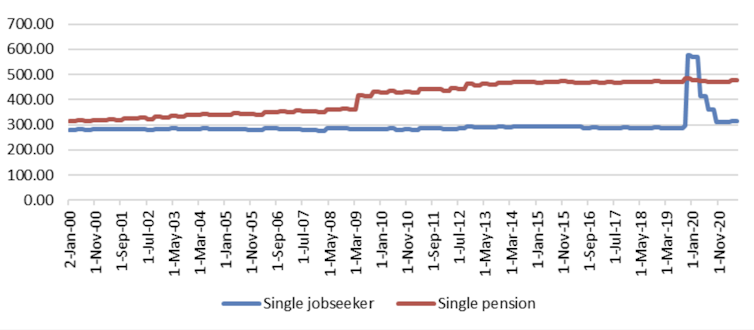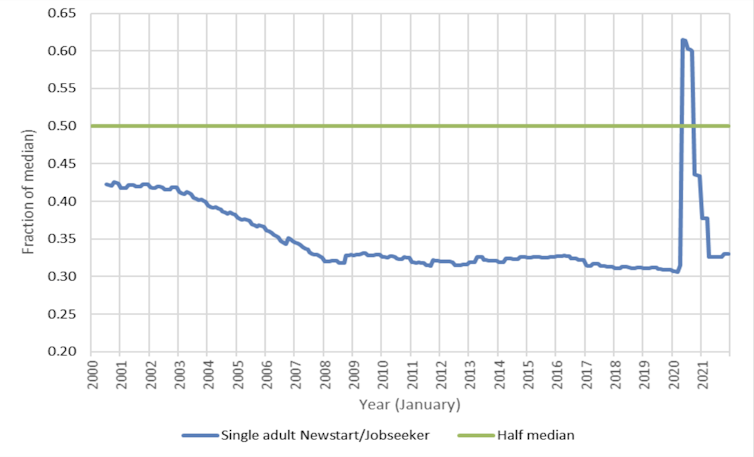Boosting JobSeeker is the most effective way to tackle poverty: what the treasurer’s committee told him
The Economic Inclusion Advisory Committee says increasing JobSeeker is the most pressing priority for the Albanese government. This is why.
Federal Treasurer Jim Chalmers and Minister for Social Services Amanda Rishworth established an Economic Inclusion Advisory Committee in December 2022 to advise the government on ways to lift economic inclusion and reduce disadvantage.
I am a member of that committee, which was tasked with reporting to the government at least two weeks prior to the federal budget in May – enough time to include a response to in the budget.
The committee delivered its report to the government in late February. The goverment made it public this week.
There are 37 recommendations – too many to discuss in detail here. The most pressing concern, and the most important for immediate policy action, is to substantially increase the JobSeeker payment for the unemployed.
Apart from a temporary boost during the COVID-19 pandemic, the payment (previously known as the NewStart Allowance) has declined relative to median incomes and other welfare payments for several decades.
JobSeeker Payment relative to Age Pension, 2000 to 2021

Interim Economic Inclusion Advisory Committee, 2023–24 Report to the Australian Government
The committee has recommended restoring the relativities of the mid-1990s, when the unemployment benefit was about 90 per cent of the age pension. This would require increasing the current rate for singles (now 65 per cent of the age pension) from A$693 to $958 a fortnight – or from about $49.50 to about $68 a day.
How we made our decision
We compared the JobSeeker payment with a range of metrics such as the age pension, minimum wage, budget standards, average weekly earnings and various poverty lines such as the Henderson Poverty Line maintained by the University of Melbourne.
There is no right level for JobSeeker (or any other welfare payment) and there is no single methodology that provides all the answers.
But all the metrics tell the same story: JobSeeker has drifted behind all these benchmarks, largely due to being indexed to the Consumer Price Index rather than wages or incomes.
JobSeeker Payment relative to half median equivalised disposable income, 2000 to 2021

Interim Economic Inclusion Advisory Committee, 2023–24 Report to the Australian Government
Given the committee only had a couple of months to draft a report, it was not possible to review all aspects of the welfare system – such as the age pension, disability support payments and family payments – or the many other aspects that affect economic inclusion.
The greatest, most urgent, need
Nonetheless our judgement is the evidence shows the most urgent need of policy attention is the precarious financial situation for almost 1 million Australians that depend on JobSeeker and associated payments such as a Youth Allowance
The 4 million Australians receiving other payments (age pension, disability pension, veterans pension, parenting payments and carer payments) are more likely to be matching up to adequacy benchmarks. There was a substantial boost to most pension payments following the 2009 Harmer Pension Review.
The committee also found Rent Assistance is inadequate and not keeping up with rental costs for most low-income households. It too requires an urgent and substantial increase.
But the highest priority is JobSeeker, as the most effective payment to lower financial stress and poverty. JobSeeker has a larger budget and is better targeted than Rent Assistance to those in most financial need.
What will it cost?
Increasing JobSeeker and associated working age payments would cost the federal budget about $5.7 billion in 2023, according to Australian National University’s PolicyMod model of Australia’s tax and transfer system. Over the four years of forward estimates (2023 to 2026), the cost would be about $24 billion.
The total cost of welfare payments in 2023-24 is expected to reach A$145 billion. So $5.7 billion, while a substantial additional expense, does only represent a 4 per cent increase in the welfare cash payments, and less than 1 per cent of the total federal budget.
The available evidence outlined in the report suggests the recommended increase would be unlikely to greatly impact participation, given the payment would still be substantially lower than the minimum wage. Indeed the committee’s judgement was that leaving it at the current rate may be a net negative for participation, with poverty being a barrier to employment.
The welfare system in Australia is supposed to provide an adequate safety net but for nearly a million Australians the system is not achieving this vital goal.
The government has an opportunity in the next budget to right a significant wrong for a group of some of the most disadvantaged people in a mostly otherwise wealthy nation.
This article is republished from The Conversation under a Creative Commons license. Read the original article.
You may also like
Relaxing disciplinary measures could lead to better school results
Relaxing strict school discipline policies could lead to better test results and improved school culture, according to a study from The Australian National University (ANU).
Want your kids to do well at school? It takes more than motivation
ANU research shows the key to academic success is to help students learn better, not try harder.
Pooh Bear’s Corner reminds us of the power of pausing
One of Australia’s most iconic roadside shrines can tell us a lot about the joy of journeying, ANU research reveals.
